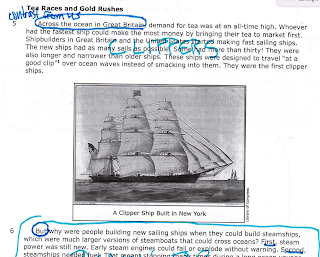Transitions are tools to connect ideas. I worry that the focus sometimes is on using them for templates or graphic organizers for writing instead of thinking about how they help the reader follow the writer's path. That means that our instruction has to help students consume texts by noticing how writers connect the ideas in paragraphs. Then we have to help students revisit their writing to see what transitional pavers they need to lay down for their readers.
Let's take a walk through how that might look. This is the passage students read for the stand alone writing field test in 5th grade.
First, I process the title. The topic is going to be Steam and Sail. I mark that with a small t. I predict that the article will be comparing those topics. I mark that with a little light bulb.
Now my purpose for reading changes. I find where the introduction begins and ends. I know that it begins and ends with the first paragraph because the first heading begins after that. Now my purpose shifts to find how the writer is hooking me and what the thesis is. I'm also reading to see if this article will be comparing steam and sail. I can see that they start talking about railroads and then use a transition word - but. This signals me to know that the writer is shifting to a new topic that contrasts with this one. Then I read that steamboats and sailboats cause changes! Now I know that we aren't really comparing steam and sail. I'm reading to know how they caused change.
Now I preview the headings: Full Steam Ahead, Tea Races and Gold Rushes, and The Next Big Things. I have an idea now about the topics for each section.
At this point, I'm ready to read until the text starts talking about something else. The transitional phrase, "After Fulton's success" tells me that the writer is moving on to a new topic - what happened after Fulton invented the steamship. I stop to think about what this paragraph told me. Basically, it was about how fast the steamship was as an improvement to previous ways to travel.
I use the same process to understand the next paragraph. But something interesting happens here between paragraph 3 and four.
Before, we had a transitional word, "but," that transitioned between sentences and ideas. Then we had a transitional phrase, "After Fulton's success," that moved us to sequence and another topic between paragraphs. Now we have the word "rivers" at the end of paragraph 3 and the connection to specific rivers in paragraph four. This is a topical transition between paragraphs that moves the reader from general (rivers) to the specific (the Mississippi and Ohio.) As I stop to think about what this paragraph is doing, I realize that the writer is explaining the impact, or effect of the steamship. When I connect that to the thesis of change, I realize the change is about where people traveled and moved.
When I process the ideas in the next section, I realize that paragraphs 5 and 6 are offering another contrast as a whole section because of the transition word, "But." I also see a new type of transition: "Across the ocean in Great Britain." This is a conceptual transition that helps the reader know the setting has changed.
I learn about clipper ships and the changes they brought in paragraph 5. When I see paragraphs 6 and 7, I see that they are both talking about why people were still using clipper ships even though steamships had been invented. First, second, and third are not transition words here. They are words that help the reader keep track of the number of reasons the clippers were preferred.
When moving to paragraph 8, we see another topical transition. Notice how paragraph 7 ends with "tea races" and getting there "first"? Paragraph 9 uses the words also and speed to introduce another topic. We've moved from tea races to the Gold Rush.
The next heading provides the conclusion with a transitional phrase that indicates sequence and the passing of time, "A time went on." The thesis is revisited in the last sentence.
Are we teaching these types of transitions? Or are we just teaching transitions as a list of words?
- Single words and how they function within sentences as well as paragraphs
- Paragraph blocs and how they are structured (compare contrast)
- Transitional phrases and how they function
- Topical transition concepts from the end of one paragraph to another
- Conceptual transitions and how they function
- Transitions and how they help us follow the writer's meaning and organizational structure
Y'all. I just think this is so important. We need to look at how real writers move between ideas in sentences, paragraphs, in paragraph blocs, in headings before we start offering graphic organizers that don't really match what writers need to say. You don't know what transitions you are going to need until you decide how your ideas are related. And to make those decisions as a writer, the best models we have are out there as published work - what real writers are doing - rather than offering things people don't actually do like first, next, then, finally. Meaning dictates form (Vygotsky).






